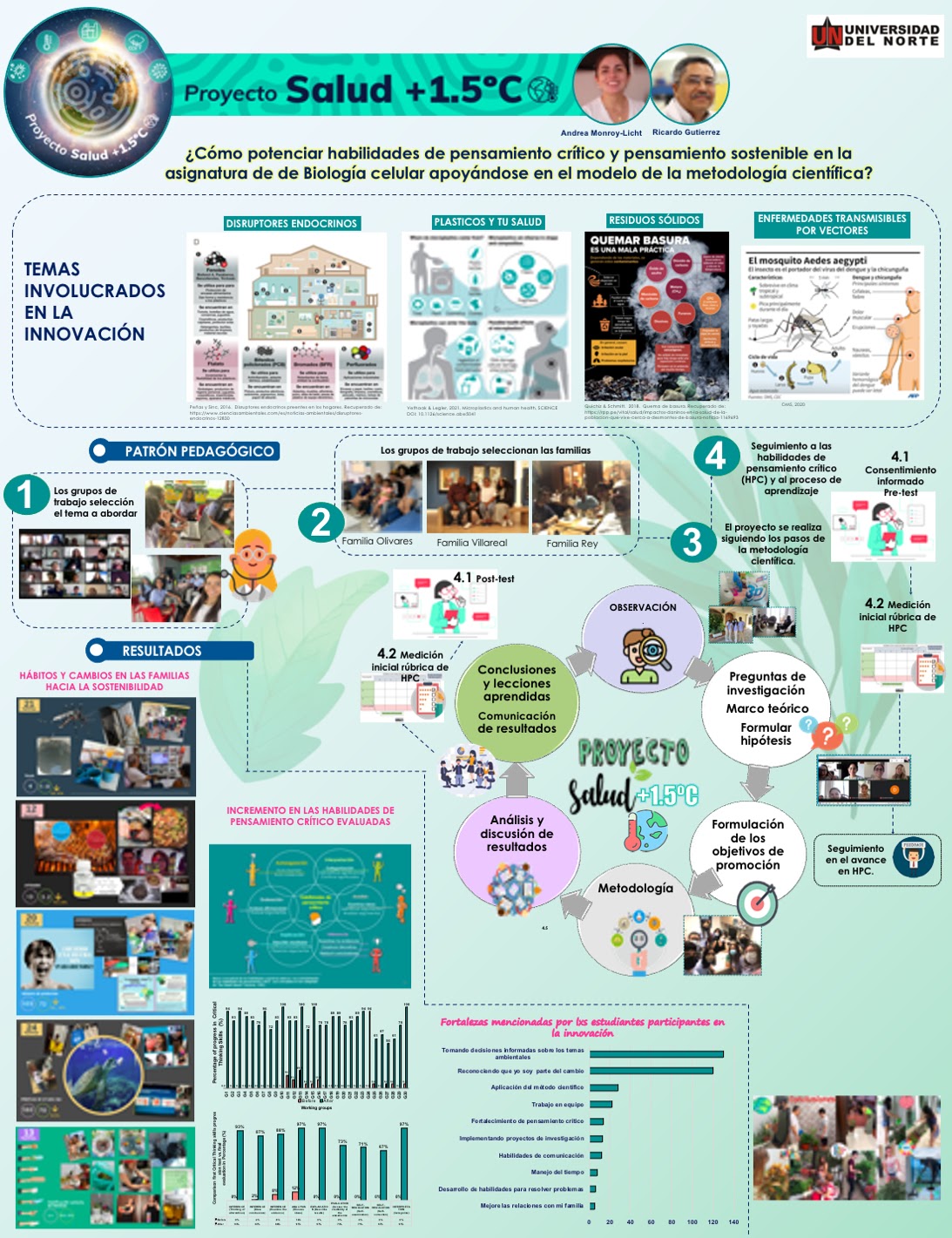¿Qué es proyecto Salud +1.5ºC?
La innovación de aula Proyecto Salud +1.5ºC se desarrolla en la asignatura de Biología celular y busca sensibilizar a estudiantes de primer semestre de medicina a través de acciones frente al cambio climático y la contaminación ambiental y su impacto en la salud humana. Se fundamente en la cognición situada como estrategia de aprendizaje significativo. Los contenidos del curso que se abordan en la innovación incluyen: diversidad celular (bacterias y virus), biomoléculas, sistema endocrino, Metabolismo, Ciclo celular y reproducción. A través del desarrollo de estrategias implementadas en los hogares de los/las estudiantes, se abordan actividades asociadas a los temas: enfermedades transmitidas por vectores (ETV), riesgos para la salud asociados a los microplásticos, efectos de contaminantes ambientales como disruptores endocrinos y/o carcinógenos, gestión de residuos sólidos. Desde esta perspectiva, las acciones propuestas están alineadas con los Objetivos de Desarrollo Sostenible (ODS), los cuales proporcionan un marco para considerar la acción climática, dentro de las diversas dimensiones de la sostenibilidad. Se involucran los ODS 3 (Salud y Bienestar), 11 (Ciudades y comunidades sostenibles), 12 (Producción y consumo responsable) y 13 (Acción por el clima). Paralelamente se potencia el desarrollo de habilidades de pensamiento crítico (CTS por sus siglas en inglés) frente a estos retos del planeta. Esta innovación ha conllevado a que l@s estudiantes construyan comunidades de aprendizaje que vinculan a sus familiares, sus pares y profesores guías de esta experiencia.
Proyecto Salud +1.5ºC (Project The Health +1.5ºC) is a pedagogical innovation that involves first-year medical students in the Cell Biology course in addressing the challenges posed by climate change to life on planet Earth. The emphasis on +1.5ºC refers to the increase in global temperature by 1.5ºC, which is dangerous because it can cause irreversible damage to the planet's ecosystems and natural resources. This leads to challenges not only in ecological, economic, and social terms but also in the direct effects of global warming and environmental pollution on human health, which are largely unknown to most people. From this perspective, the development of the subject can articulate the Sustainable Development Goals (SDGs), 3: Health and Well-being, 6: Clean water and sanitization, 11: Sustainable Cities and Communities, 12: Responsible Production and Consumption and 13: Climate Action (UN, 2022); to health problems such as vector-borne diseases (VTE), health risks associated with microplastics, effects of environmental pollutants with carcinogenic or endocrine disruptor potential, and solid waste management in the home. These topics are related to subject contents such as Cell diversity and non-cellular entities (viruses), Biomolecules, Endocrine system, Metabolism, Cell cycle and cell division. We seek that our students not only learn biology concepts, but that they can apply them in real contexts through the model of situated cognition. This theory is oriented towards meaningful learning and promotes the transfer of knowledge to real life situations (Choi & Hannafin, 1995).
At the same time, critical thinking skills (CST) are developed in the face of these global problems. The HPCs addressed in this innovation are: Interpretation (categorization), Analysis (examining ideas), Inference (examining evidence, conjecturing alternatives and deducing conclusions), Explanation (describing results), Evaluation (evaluating statements) and Self-regulation (self-examination) selected according to Facione's (1990) approach.
The results show that the students build learning communities that link their families, peers and teachers who are guides of this experience. Progress was also observed in the HPC evaluated, especially in the sub-skills describing results with 97%, in categorization with 97%, in conjecturing alternatives 93% and in examining ideas 85%. Similarly, the pre-post comparison shows progress in the concepts associated with the Cell Biology course.
At the same time, sustainable thinking and leadership in environmental action are strengthened and clear strategies are contributed towards the fulfillment of the SDGs addressed. Regarding the previously mentioned topics, students are able to connect their families with prevention actions against infectious diseases, specifically Dengue fever. They raise awareness among their families about carcinogenic compounds and endocrine disruptors found in the home, such as certain foods, cleaning and disinfecting products, perfumes, soaps, and others. These compounds not only cause health problems in humans but also negatively affect the health of other organisms in aquatic ecosystems. In addition, by discussing diseases associated with microplastics, families are encouraged to reduce their consumption of single-use plastics and to consider sustainable alternatives. Through the analysis of the impact of inadequate solid waste management on human health, family members are encouraged to sort and reduce their solid waste, as well as to reuse and recycle it.
References:
Choi, J.-I., & Hannafin, M. (1995). Situated cognition and learning environments: Roles, structures, and implications for design. Educational Technology Research and Development, 43(2), 53–69. https://doi.org/10.1007/BF02300472
Facione, P. A. (1990). Critical Thinking : A Statement of Expert Consensus for Purposes of Educational Assessment and Instruction Executive Summary “ The Delphi Report. The California Academic Press, 423(c), 1–19. https://doi.org/10.1016/j.tsc.2009.07.002
UN. (2022). Sustainable Development Goals. 17 Goals to Transform Our World. https://doi.org/https://www.un.org/sustainabledevelopment/es/objetivos-de-desarrollo-sostenible/
Link al patrón pedagógico 🙋
CONOCE EL PROYECTO COMPLETO AQUÍ 👇




Comentarios
Publicar un comentario